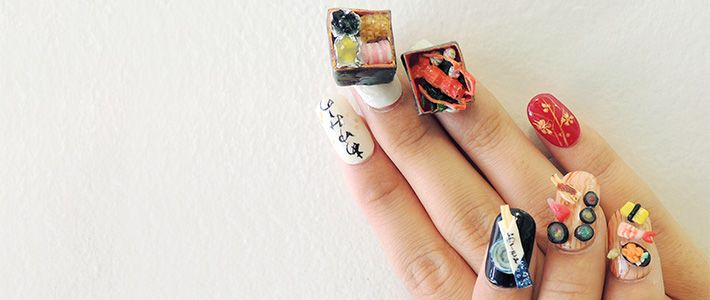
Japan’s Beauty Salons Becoming Tourist Destinations
Economy Culture- English
- 日本語
- 简体字
- 繁體字
- Français
- Español
- العربية
- Русский
A Spike in “Inbound Consumption”
With the number of foreign visitors to Japan continuing to rise, the commercial sector is looking to open up consumer demand among inbound tourists. According to the Japan National Tourism Organization, 13.4 million foreign tourists visited Japan in 2014. And the first half of 2015 saw a record number of overseas visitors, at around 9.1 million, marking a 46% year-on-year increase.
The lavish spending of Chinese tourists in Japan, which has been highlighted in numerous media reports in recent years, has increased further in the wake of the government expanding the list of tax-free items for foreign visitors to include cosmetics and other items, starting in October 2014. In 2014, according to the Japan Tourism Agency's estimates, “inbound consumption” rose to ¥2.278 trillion, a roughly 40% increase compared to the previous year.
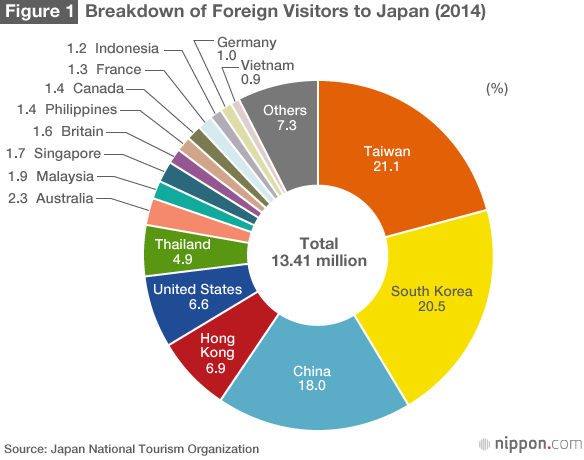
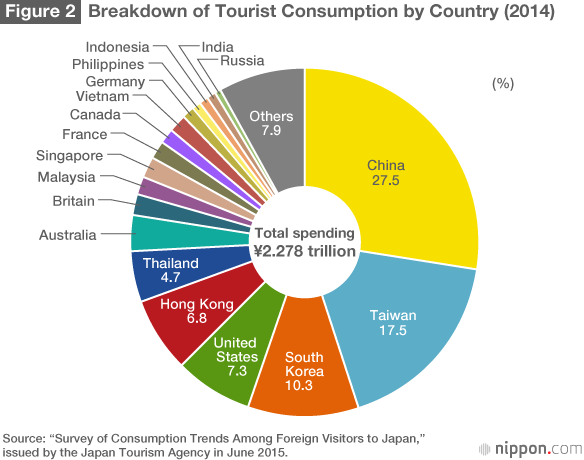
Beauty Salons Offer Japanese-style Hospitality
Many established industries in Japan face the dilemma of a market that is either mature or shrinking as a result of Japan’s aging population, and attracting more inbound consumption is a way for them to boost their revenues. Beauty salons are an example of a mature industry in Japan, but foreign visitors have long appreciated the high quality of their services. This raises the possibility that beauty salons could be one of the centerpieces of the hospitality Japan extends to visitors from overseas.
Hot Pepper Beauty Academy has been conducting various surveys and seminars related to beauty salons to gauge consumer sentiment. In February 2015, it conducted a survey centered on women who had visited Japan from one of the top four points of embarkation for tourism to Japan (China, Hong Kong, South Korea, and Taiwan) in order to find out more about the possibilities of inbound business for the nation’s beauty salons.
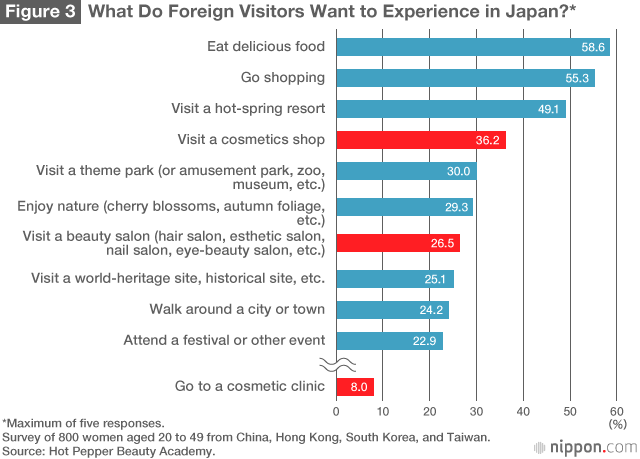
As figure 3 shows, nearly a third of the women surveyed were interested in visiting a beauty salon, which is more than the number interested in visiting a famous historical site. This shows the potential for the industry as a complement to the already deep-rooted popularity of purchasing cosmetics while in Japan.
The survey also measured what was most pleasing to foreign visitors to Japan who actually visited a beauty salon. According to the survey, some of the most pleasing elements were the cleanliness of the salons, the skill level of the staff, and the ability of the salon to deliver a result that matched the customer’s expectations. Another positive factor was that the customers felt it was safe to leave their belongings to the care of the salon staff. All of these factors might seem a matter of course to Japanese customers, but to many overseas visitors they were examples of Japanese-style hospitality.
Nail salons in Japan are particularly popular for the creative designs and detailed care they offer. In the spotlight these days are the designs of so-called itanail, which literally means “pain nails,” since the styles are so flashy that it almost hurts to look at them. These designs often feature such unusual motifs as anime characters or types of sushi. In a survey conducted among 600 respondents from China, Hong Kong, South Korea, Taiwan, Thailand, and the United States who visited Japan within the past year, there was great interest in nail salons, with 10% saying they had already visited a salon, 22.3% expressing a strong desire to visit one, and another 26.5% expressing some interest in stopping by a nail salon.
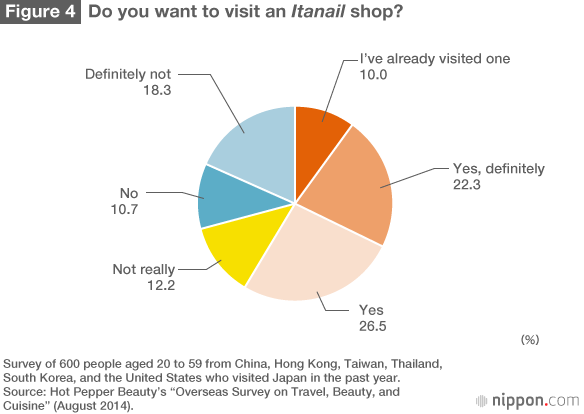
Offering Resources in Foreign Languages
One major challenge for foreign visitors in using beauty salons is their inability to speak Japanese. Tourists noted the difficulties they faced in making a reservation or figuring out how to get to the salon. In order for salons to attract more foreign visitors, they will need to do a better job of making information available to the visitors in their own native languages.
The Forcise network of 27 beauty salons nationwide is an example of the sort of initiatives that are underway to hone inbound strategies. The network holds regular training courses aimed at not only improving the general English skills of salon staff but also practicing the use of English from the customer counseling stage all the way through to the final stages of styling a person’s hair by practicing on foreign volunteers.
Along with using English websites, informational magazines, and social networking services to publicize itself, Forcise has been teaming up with tourist boards in Tokyo and Osaka and travel agents to put together the Kawaii Tour, a packaged tour that offers tourists the chance to visit beauty salons.
Beauty Services for Muslim Visitorss
In 2014, the number of visitors to Japan from the largely Muslim country Malaysia rose 40% compared to the previous year as a result of Japan waiving short-term visa requirements in July 2013. Similar visa requirements for Indonesia, another Muslim country, were lifted in December 2014, so the number of Indonesians visiting Japan is also expected to rise.
This influx of tourists from Muslim countries has raised the need for an inbound strategy—even in the area of beauty services—that raises awareness about the halal needs of these visitors and takes steps to meet those needs.
Figure 5: Ranking of Countries Respected for their Beauty Care in Southeast Asian Countries
| Thailand | Indonesia | |||
|---|---|---|---|---|
| 1 | South Korea | 74% | Japan | 49% |
| 2 | Japan | 64% | South Korea | 41% |
| 3 | France | 37% | France | 24% |
| Malaysia | Philippines | |||
| 1 | South Korea | 56% | South Korea | 53% |
| 2 | Japan | 48% | United States | 47% |
| 3 | United States | 25% | Japan | 43% |
| Singapore | Vietnam | |||
| 1 | South Korea | 61% | South Korea | 78% |
| 2 | Japan | 55% | France | 37% |
| 3 | Taiwan | 27% | Japan | 32% |
Survey via the Internet of women aged 20 to 49 in the following places: Indonesia (Jakarta), Malaysia (Kuala Lumpur), the Philippines (Manila), Singapore, Thailand (Bangkok), Vietnam (Hanoi and Ho Chi Minh City).
Source: Hot Pepper Beauty Academy’s “Survey of Beauty Care Awareness in ASEAN Countries” (August 2013).
One beauty salon in Tokyo that has been drawing attention for its efforts to meet the needs of Muslim customers is the Solpisca salon located in the Ebisu district of the capital. It has been offering Muslim-specific services since 2013. There are various points that need to be taken into consideration, such as the fact that Muslim women cover their hair with a hijab and cannot show their hair uncovered to any man who is not a close relative. This means that all of the salon staff have to be women. Another point is that hair products cannot contain any alcohol or pork-derived ingredients.
Such efforts to open up the inbound market for Japan’s beauty industry are only just getting underway. But undoubtedly there is great potential for this market, considering the positive view that many foreign tourists have of Japan’s beauty salons.
(Report was compiled by Nippon.com based on surveys conducted by Recruit Lifestyle’s Hot Pepper Beauty Academy as well as information provided by the researcher Tanaka Kimiko. Banner photo: nail art featuring a sushi motif. © Jiji Press.)tourism beauty China ASEAN nail art inbound Halal beauty salons